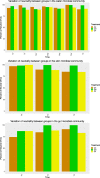Community recovery dynamics in yellow perch microbiome after gradual and constant metallic perturbations
- PMID: 32041654
- PMCID: PMC7011381
- DOI: 10.1186/s40168-020-0789-0
Community recovery dynamics in yellow perch microbiome after gradual and constant metallic perturbations
Abstract
Background: The eco-evolutionary processes ruling post-disturbance microbial assembly remain poorly studied, particularly in host-microbiome systems. The community recovery depends not only on the type, duration, intensity, and gradient of disturbance, but also on the initial community structure, phylogenetic composition, legacy, and habitat (soil, water, host). In this study, yellow perch (Perca flavescens) juveniles were exposed over 90 days to constant and gradual sublethal doses of cadmium chloride. Afterward, the exposure of aquaria tank system to cadmium was ceased for 60 days. The skin, gut and water tank microbiomes in control and treatment groups, were characterized before, during and after the cadmium exposure using 16s rDNA libraries and high throughput sequencing technology (Illumina, Miseq).
Results: Our data exhibited long-term bioaccumulation of cadmium salts in the liver even after two months since ceasing the exposure. The gradient of cadmium disturbance had differential effects on the perch microbiota recovery, including increases in evenness, taxonomic composition shifts, as well as functional and phylogenetic divergence. The perch microbiome reached an alternative stable state in the skin and nearly complete recovery trajectories in the gut communities. The recovery of skin communities showed a significant proliferation of opportunistic fish pathogens (i.e., Flavobacterium). Our findings provide evidence that neutral processes were a much more significant contributor to microbial community turnover in control treatments than in those treated with cadmium, suggesting the role of selective processes in driving community recovery.
Conclusions: The short-term metallic disturbance of fish development has important long-term implications for host health. The recovery of microbial communities after metallic exposure depends on the magnitude of exposure (constant, gradual), and the nature of the ecological niche (water, skin, and gut). The skin and gut microbiota of fish exposed to constant concentrations of cadmium (CC) were closer to the control negative than those exposed to the gradual concentrations (CV). Overall, our results show that the microbial assembly during the community recovery were both orchestrated by neutral and deterministic processes. Video Abtract.
Keywords: Community assembly; Disturbance; Evolutionary forces; Fish microbiome; Metagenomics; Neutrality; Pathogens; Recovery; Stress gradient.
Conflict of interest statement
The authors declare that they have no competing interests.
Figures










Similar articles
-
The yellow perch (Perca flavescens) microbiome revealed resistance to colonisation mostly associated with neutralism driven by rare taxa under cadmium disturbance.Anim Microbiome. 2021 Jan 5;3(1):3. doi: 10.1186/s42523-020-00063-3. Anim Microbiome. 2021. PMID: 33499999 Free PMC article.
-
Effects of predation stress and food ration on perch gut microbiota.Microbiome. 2018 Feb 6;6(1):28. doi: 10.1186/s40168-018-0400-0. Microbiome. 2018. PMID: 29409543 Free PMC article.
-
Fish Skin and Gut Microbiomes Show Contrasting Signatures of Host Species and Habitat.Appl Environ Microbiol. 2020 Aug 3;86(16):e00789-20. doi: 10.1128/AEM.00789-20. Print 2020 Aug 3. Appl Environ Microbiol. 2020. PMID: 32503908 Free PMC article.
-
Priority effects in microbiome assembly.Nat Rev Microbiol. 2022 Feb;20(2):109-121. doi: 10.1038/s41579-021-00604-w. Epub 2021 Aug 27. Nat Rev Microbiol. 2022. PMID: 34453137 Review.
-
Functional and phylogenetic assembly of microbial communities in the human microbiome.Trends Microbiol. 2014 May;22(5):261-6. doi: 10.1016/j.tim.2014.01.011. Epub 2014 Mar 5. Trends Microbiol. 2014. PMID: 24618403 Free PMC article. Review.
Cited by
-
Characterization of gill bacterial microbiota in wild Arctic char (Salvelinus alpinus) across lakes, rivers, and bays in the Canadian Arctic ecosystems.Microbiol Spectr. 2024 Mar 5;12(3):e0294323. doi: 10.1128/spectrum.02943-23. Epub 2024 Feb 8. Microbiol Spectr. 2024. PMID: 38329329 Free PMC article.
-
Microbiomes of clownfish and their symbiotic host anemone converge before their first physical contact.Microbiome. 2021 May 17;9(1):109. doi: 10.1186/s40168-021-01058-1. Microbiome. 2021. PMID: 34001275 Free PMC article.
-
Mercury and Arctic Char Gill Microbiota Correlation in Canadian Arctic Communities.Microorganisms. 2024 Nov 28;12(12):2449. doi: 10.3390/microorganisms12122449. Microorganisms. 2024. PMID: 39770652 Free PMC article.
-
The ecology and plasticity of fish skin and gill microbiomes: seeking what matters in health and disease.FEMS Microbiol Rev. 2025 Jan 14;49:fuaf027. doi: 10.1093/femsre/fuaf027. FEMS Microbiol Rev. 2025. PMID: 40577810 Free PMC article. Review.
-
Chronic exposure to high-density polyethylene microplastic through feeding alters the nutrient metabolism of juvenile yellow perch (Perca flavescens).Anim Nutr. 2022 Feb 5;9:143-158. doi: 10.1016/j.aninu.2022.01.007. eCollection 2022 Jun. Anim Nutr. 2022. PMID: 35573095 Free PMC article.
References
Publication types
MeSH terms
Substances
LinkOut - more resources
Full Text Sources

